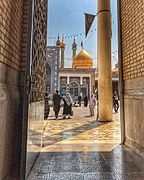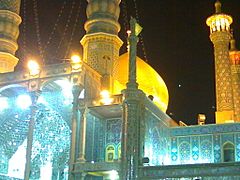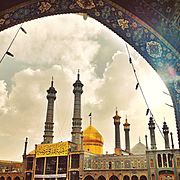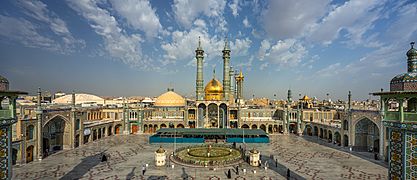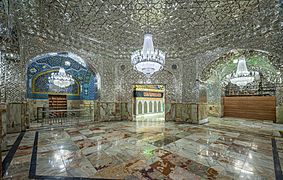Fatimah bint Musa facts for kids
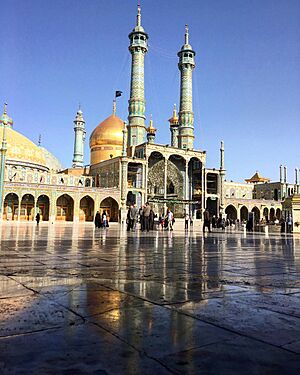
Fatima bint Musa (born around March 22, 790 AD – died around November 7 or 9, 816 AD) was a very important woman in Shia Islam. She is often called Fatima al-Ma'suma. She was the daughter of Musa al-Kazim, who was the seventh Twelver Shia Imam. She was also the sister of Ali al-Rida, the eighth Twelver Shia Imam.
Every year, millions of Shia Muslims travel to Qom, a city in Iran. They visit her shrine there to show their respect and honor her.
Fatima al-Ma'suma was the oldest daughter of Imam Musa al-Kazim. Many Shi'ites believe she was the holiest of his children, after her brother Ali al-Rida.
Important Shia Imams have spoken highly of Fatima al-Ma'suma. For example, Ja'far al-Sadiq, the sixth Imam, and Ali al-Rida, the eighth Imam, said that anyone who visits Fatima al-Ma'suma in Qom will go to heaven. Muhammad al-Jawad, the ninth Imam, also said this.
One special thing about Fatima al-Ma'suma is her ability to intercede. This means she can speak to God on behalf of others. According to narrations from Imams Ja'far al-Sadiq and Ali al-Rida, she will intercede for Shi'ites on the Day of Judgment. This will help them all enter Paradise.
Another unique thing about Fatima al-Ma'suma was that her birth was predicted. This was very unusual for children of the Shi'ite Imams. Imam Ja'far al-Sadiq predicted her birth about 45 years before she was born. These predictions even mentioned her name, her father's name, and where she would be buried.
Imam Ja'far al-Sadiq also said that Fatima al-Ma'suma's shrine in Qom is like visiting all the Shi'ite Imams. This means that when someone visits her shrine, it is as if they have visited all twelve Imams.
Her title, "al-Ma'suma," was given to her by her brother, Ali al-Rida. In Arabic, "al-Ma'suma" means pure and innocent. By giving her this name, Ali al-Rida showed that Fatima al-Ma'suma was a very pure and innocent person. This is very important to Shi'ites and shows her high spiritual status.
Contents
Fatima al-Ma'suma's Early Life and Journey
Even before Fatima al-Ma'suma was born, Shi'i Imams spoke about her holiness. She grew up with two Imams guiding her: her father and her brother. People believe she learned a lot from them.
Fatima al-Ma'suma was born in Medina in the year 173 AH. She spent her first six years learning from her father, Imam Musa al-Kazim. Scholars say she had a special gift for knowledge and spiritual understanding, even as a child.
When she was ten years old, her father was sent to prison by Harun al-Rashid. This was the fifth caliph of the Abbasid Caliphate. This separation was very hard for Fatima. However, her brother Ali, who was 25 years older, took care of her.
Family Background
Ali and Fatima were two of Imam Musa al-Kazim's 37 children. They were special because they were the only two children from his marriage to Najma Khatun. Their mother, Lady Najma, was from North Africa. She became very knowledgeable in Islamic teachings. This happened under the guidance of Imam Musa al-Kazim's mother, Lady Hamida.
Ali later became the eighth Imam and was known as Imam Ali al-Rida. The historian al-Tabari said that 'Al-Rida' means "The One Well-pleasing [to God] from the House of Muhammad."
Journey to Khorasan
In the year 200 AH, the caliph al-Ma'mun asked Ali al-Rida to travel to Khorasan. This meant Fatima al-Ma'suma had to live apart from her brother. After one year of being separated, Fatima al-Ma'suma decided to join him.
She did not just want to be near her brother. Scholars also believe her knowledge and strong faith would help her brother. This was especially true in his political role, particularly with decisions about women.
In 201 AH, she began her journey. She traveled with a group of 23 family members and friends of Imam Ali al-Rida. Another group of 12,000 people was also traveling to Khorasan.
However, the caravans never reached Khorasan. They were attacked by agents of the caliph in a place called Saveh. Some people escaped, but many were hurt, captured, or killed. Fatima al-Ma'suma survived the attack. But she had to witness the murders of 23 close family members and friends.
It is said that a woman then poisoned Fatima al-Ma'suma. Fatima became very ill. She asked to be taken to Qom. She died there and was buried on the land of her host.
Birth Predictions of Fatima
There are two stories from different people about Imam Ja'far al-Sadiq predicting Fatima's birth. Both predictions mention that she would help Shi'ites. She would intercede for them or help them enter Heaven by visiting her Shrine. These predictions were made even before her father was born. This was about 45 years before Fatima's birth.
Lady Hamida was the mother of Fatima's father, Imam Musa al-Kazim. She was also the owner of Fatima's mother, Lady Najma. Lady Hamida had a dream where the Prophet told her that Najma should marry her son. This was so she could give birth to "the best people in the world." While Najma was mainly focused on her son, Imam al-Rida, she also gave birth to Fatima from this marriage.
Gallery
See also
 In Spanish: Fátima bint Musa para niños
In Spanish: Fátima bint Musa para niños
- Holiest sites in Shia Islam


